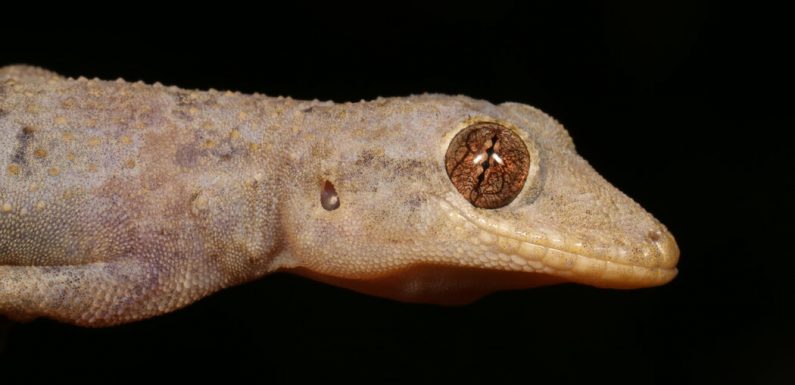
If you see a gecko scampering up the side of a house in Florida or somewhere in Central or South America closer to the Equator, there is good chance it is an African house gecko, Hemidactylus mabouia.
Little and brown, the African house gecko is now widespread in the Western Hemisphere. But the gecko originated in southeastern Africa, from Zimbabwe, Mozambique and nearby areas. So how did it cross an ocean and come here?
In a paper published on Wednesday in Royal Society Open Science, researchers have reconstructed the evolutionary history of H. mabouia, revealing it to be a diverse collection of closely related species that include as many as 20 lineages across Africa. They show that only a single lineage — Hemidactylus mabouia sensu stricto — was able to spread successfully throughout Central and West Africa as well as in the Americas.
The paper also offers a new way to test an old hypothesis — that African house geckos stowed away on vessels involved with the trans-Atlantic slave trade. The slave trade is also thought to have transported the Aedes aegypti mosquito and several earthworm species to the Americas from the African continent, and the new research further reveals its ecological effects in addition to its human toll.
Though African house geckos are much larger than a mosquito or earthworm, geckos are excellent stowaways. The small lizards live in crevices and can survive for some time without food, according to Ishan Agarwal, a herpetologist and an author of the new paper. A single stowaway gecko with a bellyful of eggs would be enough to start a new population of geckos in a new land, without attracting much notice.
“People never really looked at them,” said Aaron Bauer, a herpetologist at Villanova University and a co-author of the paper. Many herpetologists, he said, consider the geckos to be a “trash” species, meaning weedlike and uninteresting.
Dr. Bauer first thought about reconstructing the evolutionary history of the African house gecko about a decade ago. Dr. Bauer also knew of two papers from the 1960s that noted the potential link between the gecko and the trans-Atlantic slave trade. Back then, researchers lacked the technology to test the theory; but in the 2010s, Dr. Bauer could do it.
Margarita Metallinou, a postdoctoral researcher working with Dr. Bauer, helped to conceptualize the project and began sequencing some specimens. But then tragedy struck: In 2015, Dr. Metallinou died in an accident in Zambia while conducting research, which set back the project.
Dr. Metallinou’s colleagues continued the research, collecting tissue samples from museum specimens of African house geckos across the world. Their final data set included specimens from 186 geckos. Dr. Agarwal took on Dr. Metallinou’s responsibilities and did the bulk of the sequencing work.
The researchers were surprised at the significant diversity of the H. mabouia’s 20 interrelated species, Dr. Agarwal said.
Yet despite all this diversity, only one species, H. mabouia sensu stricto, managed to colonize the Americas. All the other H. mabouia geckos have restricted ranges. This raises the question of whether sensu stricto has “special traits that contribute to invasiveness, or if it was just a question of opportunity,” said Sarah Rocha, a postdoctoral researcher at the University of Vigo in Spain who was not involved in the study.
The authors have some theories. Unlike forest-bound geckos, H. mabouia sensu stricto in African countries is most often found in open spaces, including clearings and human villages. Though sensu stricto faces competition from the many other gecko species in Africa, it may have spread more easily in the Americas, which have fewer native geckos.
To test the trans-Atlantic slave trade theory, the researchers studied the routes of slave voyages and cross-referenced historical observations of the geckos in the Americas with areas involved with the slave trade. H. mabouia was recorded in the West Indies in 1643 and in Dutch-controlled Brazil around the same time, more than a century after slave ships crossed to the Americas.
The paper’s genetic results also buttress this theory, as geckos sampled from the Americas and Africa had low genetic diversity, suggesting the geckos spread to the Americas rather recently.
The authors caution that their genetic analysis does not rule out the reptiles rafting across the Atlantic a thousand years ago some other way.
But there is rarely a “smoking gun” piece of evidence, such as the mention of a gecko in a ship’s log, in this kind of research, said Christian Kull, a geographer at the University of Lausanne in Switzerland who has studied plants transported by enslaved Africans. He was not involved with the research, but said that a gecko stowing away on ships seems more plausible than a gecko “floating on a raft of water hyacinth flooded out of the Congo River across the Atlantic.”
The African house gecko is a commensal species, meaning it benefits from its adjacency to humans. It lives around our buildings and hunts by artificial lighting — a beacon for bugs. Accordingly, it would not be surprising to see a gecko aboard a ship, Dr. Kull said.
As Dr. Kull sees it, it is not necessarily the gecko’s fault that it has become so good at surviving around the world. Commensal species like geckos, rats and cockroaches may be better understood as passengers, rather than invaders. “Perhaps it is humans that are the invasive species,” he added.
Source: Read Full Article